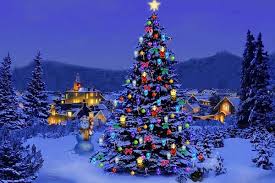- Christmas wasn’t declared an official holiday in the United States until June 26, 1870. c
- Oklahoma was the last U.S. state to declare Christmas a legal holiday, in 1907. f
- Mistletoe (Viscum album) is from the Anglo-Saxon word misteltan, which means “little dung twig” because the plant spreads though bird droppings. a
- Ancient peoples, such as the Druids, considered mistletoe sacred because it remains green and bears fruit during the winter when all other plants appear to die. Druids would cut the plant with golden sickles and never let it touch the ground. They thought it had the power to cure infertility and nervous diseases and to ward off evil. a
- Evergreens (from the Old English word aefie meaning “always” and gowan meaning “to grow”) have been symbols of eternal life and rebirth since ancient times. The pagan use and worship of evergreen boughs and trees has evolved into the Christianized Christmas tree. a
| 6. Because they viewed Christmas as a decadent Catholic holiday, the Puritans in America banned all Christmas celebrations from 1659-1681 with a penalty of five shillings for each offense. Some Puritan leaders condemned those who favored Christmas as enemies of the Christian religion. c 7. A Yule log is an enormous log that is typically burned during the Twelve Days of Christmas (December 25-January 6). Some scholars suggest that the word yule means “revolution” or “wheel,” which symbolizes the cyclical return of the sun. A burning log or its charred remains is said to offer health, fertility, and luck as well as the ability to ward off evil spirits. d 8. Because of their pagan associations, both the holly (associated with the masculine principle) and the ivy (the feminine) and other green boughs in home decoration were banned by the sixth-century Christian Council of Braga. a 9. The poinsettia is native to Mexico and was cultivated by the Aztecs, who called the plant Cuetlaxochitl (“flower which wilts”). For the Aztecs, the plant’s brilliant red color symbolized purity, and they often used it medicinally to reduce fever. Contrary to popular belief, the poinsettia is not poisonous, but holly berries are.f 10. Christmas has its roots in pagan festivals such as Saturnalia (December 17-December 23), the Kalends (January 1 -5, the precursor to the Twelve Days of Christmas), and Deus Sol Invictus or Birthday of the Unconquerable Sun (December 25). The Christian church heartily disapproved of such celebrations and co-opted the pagans by declaring December 25 as Christ’s day of birth, though there is no evidence Christ was born on that day. f |
a Allen, Linda. 2000. Decking the Halls: The Folklore and Traditions of Christmas Plants. Minocqua, WI: Willow Creek Press.
b “Christmas Trees and More.” University of Illinois Extension. 2010. Accessed: December 6, 2010.
c Collins, Ace. 2003. Stories Behind the Great Traditions of Christmas. Grand Rapids, MI: Zondervan.
d Grossman, John. 2008. Christmas Curiosities: Odd, Dark, and Forgotten Christmas. New York, NY: Stewart, Tabori & Chang
e Guinness Book of World Records. 2008. New York, NY: Bantam Dell.
f Gulevich, Tanya. 2000. Encyclopedia of Christmas. Detroit, MI: Omnigraphics, Inc.
g Highfield, Roger. 1998. The Physics of Christmas: From the Aerodynamics of Reindeer to the Thermodynamics of Turkey. New York, NY: Little, Brown and Company.
h Liebman, Lisa. 2003. Leaving You: The Cultural Meaning of Suicide. Chicago, IL: Ivan R. Dee Publisher.
i Philips, Tom. “Facebook Break-Up Chart Shows That Christmas Is a Relationship Killer.” Metro.co.uk. November 2, 2010. Accessed: November 15, 2010.



 RSS Feed
RSS Feed

